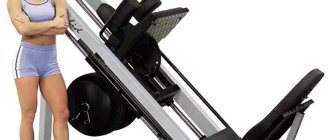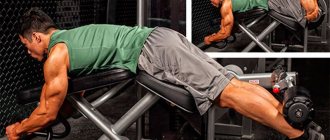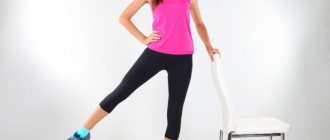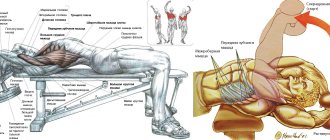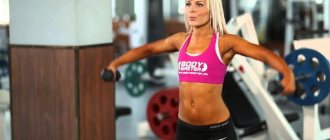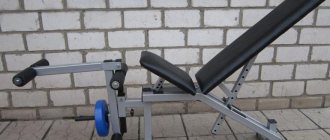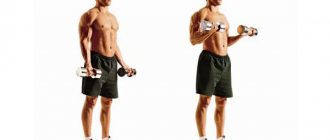Author: Timko Ilya - the ruler of the entire site and fitness trainer | more details >> Rod. 1984 Trained since 1999 Trained since 2007. Author and creator of the site tvoytrener.com. CCM in powerlifting. Champion of Russia and South Russia according to AWPC. Champion of the Krasnodar region according to IPF. 1st category in weightlifting. 2-time winner of the Krasnodar Territory championship in t/a. Author of more than 700 articles on fitness and amateur athletics. Author and co-author of 5 books.
Place in the ranking of authors:
out of competition
(become an author)
Date:
2012-05-29
Views:
817,988
Rating:
5.0
| All articles by the author >> | Medals articles >> |
Articles are loading...
| Article medals: | article in TOP 100 | more than 500 thousand views |
Why medals are given to articles:
| Bronze medal: | |
| 1. The article is in the TOP 100 2. The article has more than 3. The article has more than 100 | |
| Silver medal: | |
| 1. The article is in the TOP 50 2. The article has more than 3. The article has more than 500 | |
| Gold medal: | |
| 1. The article is in the TOP 10 2. The article has more than 1 3. The article has more than 1,000 | |
Main muscles - pectoralis major Additional - anterior delta and triceps Difficulty - medium
Load by muscle group
The load is indicated on a 10-point scale (the total load is summed up)
| Breast | 10 (high) |
| Triceps | 6 (average) |
| Anterior delta | 3 (average) |
| Total load/exercise type | 19 (medium) / basic local |
Seated press and Smith machine
Seated barbell press in a Smith machine is an exercise for the shoulders and upper chest. Let's look at both options.
Seated Angle Press
Place an incline bench under the bar of a Smith machine. Position it so that when you lie down on the bench, the bar is level with the middle of your pecs. Set the back angle to 45 degrees. This position is also called “sitting”. There is no need to hang anything yet; initially the bar weighs 20–25 kg, which is just right for warming up.
- Sit on a bench, press the top of your buttocks to the bottom of your back. Bend your lower back forward, squeeze your shoulder blades together, straighten your shoulders. Press the back of your head against the back of the bench.
- Grasp the bar with a wide grip (palms wider than shoulder width). Usually there are risks on the fingerboard that you should follow. You can do this: find the marks located closer to the edges of the fingerboard and place your ring or middle fingers on them. This makes it easier to achieve a symmetrical grip. By the way, the grip is straight.
- Remove the bar by twisting it to remove the clamps.
- Gently lower it onto your chest. The bar should be located between the shoulders and the pectoral muscle. This is the correct position. Lower it as far as possible, stretching the front deltoids and pectoral muscles.
- Lift up as you exhale, repeat 10–15 times. The warm-up is over.
Now set the desired weights and do 8-10 repetitions in 3-4 sets. If you can't squeeze out the last reps, rotate the bar in a critical position: it will lock. Or ask a friend (coach) to back you up.
There is a nuance - for some it is convenient to turn the bar away from you, for others - towards you. Experiment with how it is more convenient for you to do this. Because at the critical moment, when you need to fix the barbell, you may not succeed. That is, if turning in one direction is inconvenient for you, turn the bench 180 degrees.
Seated Vertical Press
In this case, the bench press in the simulator is an imitation of a barbell bench press while sitting on the shoulders. You need to install an inclined bench under the bar, which should be strictly above the seat (preferably in the middle). Adjust the height of the bar so that when sitting, it is level with the top of your head.
We will be lowering the barbell behind our heads, so make sure the bench position allows this to happen.
- Grab the bar with an overhand grip and lift it up. The grip is slightly wider than the shoulders, be guided by the marks on the bar (they are located exactly where they are on the free bar).
- Don't forget that this is a warm-up. This option is not suitable for girls, the weight is too heavy, it is better to rock your shoulders in a different way. Therefore, we recommend the Smith press for men. Raise and lower the empty bar 10-15 times. The warm-up is over.
We hang the pancakes, perform 3-4 approaches in 8-10 repetitions.
Description of the exercise
I do not recommend using it as a basic exercise. It’s better at the end of the “finishing” training. Good simulators are those where the distance between the hands is greater in the initial phase, and less in the final phase.
When squeezing, do not lean your shoulders forward. On the contrary, straighten your shoulders and lean them back.
Main features
1. The quality of the simulator is indicated by the presence of a lever for feeding weight. If there is no such lever, then exercising on such a simulator is dangerous. Since the first repetition will have to start from an extremely uncomfortable position with a greatly stretched chest.
2. It’s also convenient when the simulator has handles at different angles. These handles simulate different positions of the hands when bench pressing dumbbells.
3. It is advisable to lower it low enough, but so that it does not cause discomfort in the shoulders. And it’s better to squeeze it to the end.
4. The seat should be set so that the arms are in the middle of the chest or slightly lower. But not higher. Otherwise, it can cause overstrain in the tendons of the shoulder and pectoral muscles.
5. The weight needs to be selected so that you can do at least 6 repetitions. In general, exercise machines are not suitable for extreme weights. Since most simulators are not basic exercises.
6. Remove and place weights using levers.
Varieties of seated press: correct technique and significant nuances
In gyms there are various modifications of devices for performing pressing movements. They can be either load-bearing or loadable. You can train in them at an angle, as well as do horizontal and vertical bench presses: it all depends on the design of the particular simulator.
All such simulators are characterized by a common algorithm of actions.
Before starting the class, you should warm up your upper body, paying special attention to your shoulder joints. Before the first approach, install a small weight: this will be a warm-up set.
V
Bench press in a special machine
Many gyms have press machines that allow you to move upward at an angle, as well as horizontal presses. They are used in complex training of the upper body.
Almost all such devices provide the ability to adjust the seat - you need to use it by adjusting the height to suit your height. Having settled down while sitting, press your body tightly against the back, straighten your shoulders and slightly lean your chest forward. Legs spread apart rest firmly on the floor.
Holding the handles with a comfortable grip, remove the weight and hold it with your hands (if there is a special pedal for bringing the weight to the starting position, this will make the task much easier). The shoulder blades are in a flattened state, the elbows are apart.
- Exhaling, with a powerful effort, squeeze the weight in front of you until your arms straighten, maintaining a slight bend in the elbow joints (“soft elbows”).
- They are fixed in this position for a couple of seconds: the target muscles are statically tense.
- As you inhale, maintaining tension in the muscles, slowly return the handles to their original position.
V
Do 12 times in 3-4 sets.
Video: Technique for performing seated bench presses in a machine
Hammer Seated Press
For performing the seated press, an ideal machine is called a “Hammer” in the sports community, after the manufacturer of such devices.
This lever type machine is simple and efficient, being operated by pushing out a lever to which a weight is attached. It was originally created to reduce the load on athletes’ joints during pressing movements.
A
The halls feature a variety of modifications of Hummers, allowing you to shift the working emphasis in the presses:
- A vertical press device that simulates similar movements with free weights. The deltoids receive the main load here.
- Angle press machine. It activates the pectoral muscles with an emphasis on its upper zone.
Before starting the lesson, the selected device must be adjusted to suit your height. The seat is installed so that the handles are placed at mid-chest level or slightly lower. The optimal weight is placed on the machine.
Having settled down on the seat, you need to press your back tightly against its back: there should not be a large distance between the exercise machine and your lower back. Feet rest on the floor.
Holding the handles of the Hummer, squeeze your shoulder blades together, spread your elbows to the sides and take a deep breath. With an optimal grip width, the forearm at the lowest point will be perpendicular to the body.
- With a powerful muscular effort, while exhaling, squeeze the weight in front of you, straightening your arms (the elbows remain “soft”, without “snapping” in the joints). Shoulders are pressed against the back, elbows pointing to the sides.
- At the top point you need to fixate for 1-2 seconds, focusing on the static contraction of the target muscles.
- While inhaling, slowly and smoothly lower the handles to their original position.
Do 12–15 repetitions in 3–4 approaches.
V
When practicing the Hummer, during the positive phase of the movement, you need to learn to resist the instinctive arching of your back. This is important, since with this technique the back muscles will take on a significant part of the load, and the spine will be subject to undesirable effects.
The lowering of the handles lasts longer than the pressing movement. Here you need to avoid sharply “throwing” your arms down, moving them under control and maintaining tension in the muscles.
V
The correct biomechanics of movement in this device implies a contracted position of the shoulder blades and a protruding chest at all points of the trajectory. There is no need to concentrate on pushing the weight out (similar to a barbell bench press). What is important here is a smooth and leisurely straightening of the arms; you should seem to be moving the weight, not pushing it.
Video: How to properly perform a bench press in a Hummer
Smith machine press to work the pectoral muscles
You can specifically work the target muscles without spending additional effort on the work of the stabilizer muscles in a Smith machine. As with other bench press machines, the Smith uses the same movements as in a free weight class, but in a more focused manner. This is due to the fact that the bar here goes strictly along the guides, the trajectory of its movement is set initially.
Press sitting in front of you at an angle in the Smith machine
First you need to set the desired angle of the bench and place it directly under the bar. It is advisable to determine the exact placement on an individual basis by performing several trial repetitions without weight. After this, the optimal weight is set.
After sitting down on a bench (the bar is in front), you need to fix the position of the body: your feet rest on the floor, your pelvis and back are pressed against the seat). The bar is taken with a straight closed grip with a wide stance of the hands, by turning it, remove it from the stoppers and lower it to approximately the level of the chin.
- As you exhale, squeeze the bar above yourself. The arms are not fully straightened, leaving a slight angle at the elbow joints.
- At the top point, pause for a second, concentrating on peak muscle contraction.
- As you inhale, lower the bar under control to its original position. There is no need to put it on your chest.
Perform 10–12 times in 3–4 approaches.
V
During movements, you should not arch your lower back - this will overload the spine and change the emphasis of the load.
Video: Press sitting in a Smith machine in front of you - pumping up the chest and shoulder muscles
Smith machine overhead press
Before you begin this exercise, you need to thoroughly warm up your shoulder joints, since they have serious work ahead of them: the overhead press is more dangerous than other similar movements.
In the Smith machine, the bar is placed in the top position, so that it can be comfortably grasped with straightened arms. A weight is placed on it. A bench with a vertical backrest is placed under the bar (if it is not available, a regular gymnastics bench will do). You should position yourself on it so that the bar is positioned exactly above your head. The abdominal muscles are statically tense, the feet rest firmly on the floor. Raising your hands, grab the bar with a grip wider than your shoulders and remove it from the stoppers.
- Inhaling, in a controlled movement, bring the barbell behind your head to approximately the middle of your head or slightly lower. In the lower position, an angle of 90 degrees should form between the joints of the shoulder and elbow. This is an average indicator; the level of lowering of the bar is determined by the flexibility of the athlete’s joints. It's important not to overdo it here.
- There is a second pause at the bottom.
- As you exhale, push the bar up with a powerful movement, avoiding “snapping” in the elbow joints.
Do 8-10 times in 3 sets.
V
To make launching the projectile more comfortable, it is permissible to tilt your head forward slightly, without allowing your back to lift off the back of the bench. The bar must move strictly along a vertical trajectory without deviation to the sides.
It is not recommended to work with heavy weights in this exercise: this increases the risk of injury to the shoulder joints.
Video: Correct technique for performing seated overhead presses in a Smith machine
Execution technique
Doing bench presses on a machine is not that difficult. The main thing is to correctly adjust the seat height to suit your height. While sitting in the simulator, observe all three points of support: shoulder blades, pelvis, feet. You also need to understand at what level the handles of the simulator should be and how this will affect the performance. Let's start in order.
Types of bench press machines
This is not about the manufacturer's brand, but about the design. There are two types:
- Lever. They are also called "Humvees". This simulator consists of two levers that move independently of each other. This gives us the opportunity to work on each chest individually. Which will help reduce the imbalance in their strength and development. To increase weight, use barbell plates. Giving us the opportunity to increase the weight gradually by taking pancakes weighing 1.25 kg. The load on lever machines is very similar to working with free weights.
- Block. The design of these simulators is more intricate. To realize the increase in weight, blocks are used, and cables are used to move them. Work in such a simulator is mainly carried out with both hands at the same time. Therefore, we cannot work on each side separately. But changing weight is much easier. You just need to set the limiter to the required number of blocks. But this makes it more difficult to progress. Since the blocks weigh from 5 to 8 kg. And not everyone can handle such an increase.
Seat height and handle position
As for the seat height, there is one important detail to understand. At what level the handles are located, we act on that area of the pectorals. In a lever simulator, the length of the levers and their angle of inclination also play a role. If they are short, then the load will go to the top of the pectorals. Therefore, the seat must be adjusted to this height. If they are long and have a large angle of inclination. Then this machine is designed for the lower chest. And of course, the intermediate size of the levers between short and long uses the middle part. That is, we already get not one, but three different simulators! In block-based, this is implemented a little differently, but the principle is the same. Where the handles are located, we act on that area.
These are all the main points you need to know before you start doing bench presses in the simulator.
Initial position:
- Adjust the seat height as described above.
- Sit on a bench press machine. Spread your legs shoulder-width apart and place your feet on the floor.
- We grab the handles with a medium grip. So that the elbow is at the same level as the hand.
- Bring your shoulder blades together and press your pelvis against the bench. At the same time, maintain a slight arch in your lower back.
- Push your chest forward as much as possible, lower your shoulders, keep your abs tense.
- As you exhale, straighten your arms and press the handles of the exercise machine forward.
This initial position will make the press even closer to the classic version. After all, no one starts pressing the barbell from the bottom position.
Performance:
- As you inhale, bend your arms by moving your elbows back. As soon as we feel that the pectoral muscles are well stretched. Take a short break.
- Then, as you exhale, forcefully press the handles of the exercise machine forward. The movement should occur through contraction of the pectoral muscles.
The main task is to focus attention not on the trajectory of movement. And on amplitude, breathing and control over the work of those muscles that we want to load. In this case it will be the breasts.
Chest press in the simulator: video
How to do the exercise? Technique
- Set the seat height of the exercise machine to the correct height for you. Sit tightly on the bench. Grab the handles. Raise the weight until your arms are actually straight. This will be the starting position.
- Lower the handles, moving your elbows back as low as possible. As you lower, inhale.
- Press from your chest to the starting position. Under load, when you press, exhale.
- Repeat the range of motion 15 times for 3 sets.
How to do a chest press in a machine? Technique
Application of the exercise
For whom . Any level for girls and men. Recommended for beginners to practice and consolidate the movement - chest press.
When . The machine chest press is best done at the beginning of training the pectoral muscles. After the press, do incline dumbbell flyes and triceps extensions from the upper block.
How many . For beginners, do 3 sets of 15 repetitions. For more experienced athletes to work on weight - 4 x 10 times.
Advice! If you come to the gym to pump your chest, and your favorite horizontal bench for barbell press is occupied. The machine chest press is a great alternative to the basic barbell press.



